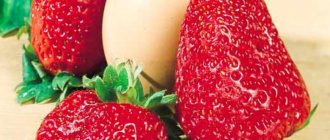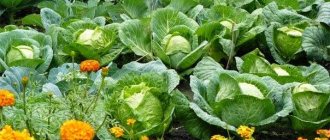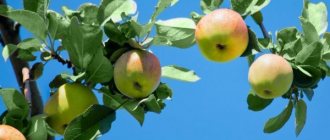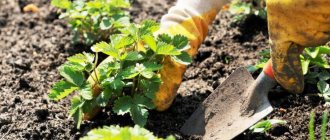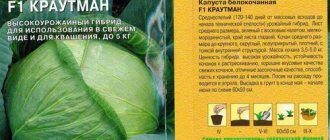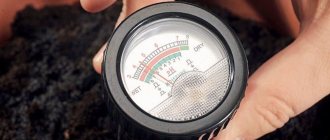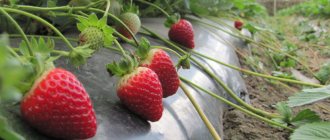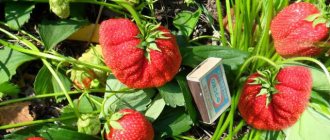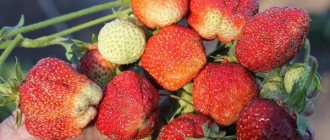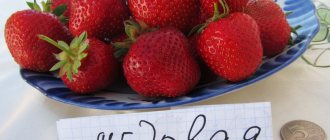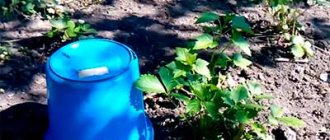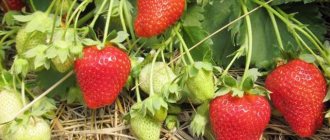Breeding and regions of strawberry cultivation by Wim Tarda
Tarda strawberries were bred by Dutch specialists. They crossed Zant and Vikoda, resulting in an improved variety of garden strawberries. Vima is a brand that, in addition to Tarda, includes Zanta, Xima, and Rina.
The variety was included in the State Register of Russia in 2021. The culture adapts well to climatic fluctuations, therefore, in addition to the southern regions, it can be grown in the Central region of Russia. Also, Wim Tarda strawberries can grow in Belarus, Moldova, and Ukraine.
Additional Information. Each strawberry contains up to 200 seeds, from which, when propagated, the same number of new bushes can grow.
Description of the strawberry variety VimaTarda
The Vima series is characterized by large bushes, dense lush foliage and strong growth of stems. Tarda is no exception. The plant forms a powerful bush with a large number of peduncles. The bush is spreading, densely leafy.
Strawberry leaves are dark green in color, very large in size, and shiny. The plates are ribbed and concave, slightly wrinkled and pubescent. The main leaf area is rounded, the base is sharp. The stipules are wide, short, and pink.
The flowers of the variety are bisexual, beautiful white, and quite large. The inflorescences are spreading, located on thick powerful peduncles and located at a level below the leaves.
The whiskers are also large and powerful, but the whisker formation of the Tarda variety is average. The color of the aerial shoots is pale red.
The fruits are held suspended by strong legs without touching the ground.
The berries are the pride of the strawberry variety. They are large, orange or dark red in color. The weight of one strawberry reaches 60 g with a good agricultural background. The shape of the fruit is cone-shaped. Some specimens are shaped like a fan or comb. The first berries weigh the heaviest (up to 45 g), the second wave produces slightly smaller specimens (about 35 g). The skin is glossy with uneven coloring and yellow seeds, slightly pressed into the pulp. According to the description of the strawberry variety Wima Tarda, the pulp of the fruit has a dense consistency. It is aromatic and juicy, contains a large amount of useful substances. Tasting score 4.3-4.5 points out of 5. The taste is sweet with a very slight hint of acid. The aroma is persistent and pleasant, reminiscent of wild strawberries. Ripe berries are covered with leaves, which makes the harvesting process longer. But this feature saves the fruits from the scorching sun.
Distinctive features and characteristics
The fruits of Vima Tarda are large, weighing 40-45 grams. Strawberries are dense, so their transportability is good.
The taste is high, due to which strawberries are used as a dessert during the season.
Dimensions and appearance of the bush
Strawberry bushes are vigorous, slightly spreading. The dark green leaf blades are large, wrinkled, and pubescent. There are many flower stalks, they are located below the level of the leaves. The color of ripe berries varies from orange to dark red. The mustache is powerful, but it grows little.
Flowering and fruiting
Wima Tarda strawberries bloom in May and begin to bear fruit in July. Fruiting is extended, gardeners produce 6-8 berry pickings. One bush is capable of growing 0.5-0.9 kilograms of ripe fruits. Productivity depends on climatic conditions and on ongoing agrotechnical measures.
Taste qualities and scope of application of berries
Tasters note the high taste qualities of the fruit. The sweet, strawberry-flavored berries are consumed primarily fresh. In addition, they are frozen, dried, and prepared into jam, jam, compote, and juice.
Susceptibility to diseases and pests
Vima Tarda is rarely affected by diseases or pests. Pathogenic microorganisms can appear when the bushes are waterlogged as a result of heavy rainfall, or when the gardener makes mistakes in care. For the winter, you need to remove plant debris in which pest larvae and pathogenic microorganisms can overwinter.
See also
Description of Pineberry strawberries, cultivation and care
Read
Frost and drought resistance
The frost resistance of Wima Tarda strawberries is average. In cold regions, it will need to be covered for the winter or grown indoors. The bushes will not tolerate prolonged drought well: the leaf blades will begin to turn yellow and dry out, the berries will form small in size and will also begin to dry out.
Main characteristics of the variety
A description of the Wima Tarda strawberry variety, photos and reviews from gardeners will help you get to know each other better, but first let’s look at the characteristics. Dutch breeders are trying to develop crops that have high yields and large fruits. Two well-known varieties were used for crossing: Zanta and Vikoda. The result was a large-fruited Tarda with an average fruit weight of 40 g.
Ripe berries acquire a rich red color with a dark tint. Yellowness appears at the tip of the fruit. The skin is bright and shiny. The shape of the berry resembles a truncated cone. Vima Tarda tastes sweet with a strong predominance of strawberry aroma. Berries can be transported. The yield from 1 hectare reaches 10 tons.
Like all representatives of the Vima series, Tarda strawberries form large bushes with strongly overgrown stems and dense green foliage. It throws out a lot of inflorescences. The stems of the peduncles are strong. Most of the ripe berries are held in weight, without bending to the ground. The weak growth of the whiskers makes it easier to care for strawberry plantings.
When considering the description of the Wima Tarda strawberry variety, it is worth paying attention to immunity. The culture is winter-resistant and also tolerates dry summers. Timely preventative spraying against pests will prevent crop loss in the future.
Important! The Vima Tarda strawberry variety does not require special care. If you want to get a large harvest of berries, you need to take the time to feed the bushes with organic matter, as well as complex mineral fertilizer.
To get a better acquaintance with the variety, let’s look at the quality indicators in Wim Tarde’s description of strawberries:
- large Tarda bushes with strong stems throw out many flower stalks;
- the yield of berries from one bush ranges from 0.8 to 1 kg of berries;
- the fruits grow large in the shape of a truncated cone;
- the minimum berry weight is 30 g, the average is 45 g, with good feeding, fruits weighing up to 50 g grow;
- the appearance of small berries at the end of fruiting is not noticeable;
- the Vima Tarda variety is able to overwinter without shelter, but there is no point in speculating on this advantage;
- the harvested crop can be transported;
- Tarda strawberries are slightly susceptible to fungal and viral diseases;
- Fruiting lasts the entire season until the onset of cold weather.
The purpose of the fruit is universal. Strawberries of the Tarda variety are delicious fresh. The berries are used to make baby puree, jam, and can be frozen. Strawberries are used to make compotes and are also used to decorate cakes and other confectionery products.
Important! Tarda strawberries are not afraid of heat treatment.
The video provides an overview of the Tarda variety:
Landing rules
When choosing planting material, you need to pay attention to the fact that the root system should be light brown in color, and the ground part should consist of 3-6 leaves. They must be elastic, without dents, damage, or stains.
Deadlines
Strawberries are planted in spring or autumn. When planting, the gardener focuses on the climatic conditions of the region. In spring, the soil should warm up to +10 °C, then the bushes will quickly and easily take root.
When planting plants in the fall, you should try to complete the procedure before the end of September so that they can take root well before the onset of frost.
Selecting a site and preparing beds for strawberries
Choose a place for planting strawberries that is sunny and not blown by northern winds. In shaded areas, berries grow of lower quality. The area is cleared of debris, dug up, fertilized with humus and superphosphate.
Preparation of seedlings
When purchasing seedlings on the market, the gardener does not know under what conditions they were stored. Therefore, it is advisable to first harden them by taking them out into the open air during the day. Before planting, the strawberry root system is dipped in a bowl of water for several hours.
Stages of the planting process
Planting strawberries on a plot is done as follows:
- at a distance of 30-35 centimeters, holes 10 centimeters deep are dug;
- the roots of the seedling are straightened, planted in the middle of the hole, and covered with substrate;
- the ground around the bushes is compacted and watered.
The beds are mulched with sawdust or humus.
Landing technology
Planting strawberries is best done on a cool and cloudy day.
Typically this procedure is carried out according to the following scheme:
Mark the bed in such a way that a distance of at least 15 cm is maintained between future bushes. Row spacing can range from 30 to 60 cm, depending on the number of lines in each row. According to the planned pattern, dig holes, the depth of which should be slightly greater than the root system of the seedling. Form a small hill at the bottom of each hole to make it easier to place the strawberry roots
If the seedlings were purchased with a closed root system (in pots), this precaution is not necessary, but the plant should be removed from the container by transferring it so as not to disturb the roots. Place the seedling in the hole, spreading the roots along the slopes of the hill. Cover the hole with soil so that the root collar (“heart”) of the seedling is strictly at the level of the ground surface: both excessive deepening of the root collar and its exposure have equally detrimental effects on the development of the bush. Carefully compact the soil so that there are no air pockets left inside. As a result, the seedling should be slightly deeper in relation to the general level of the bed
Over time, the plant will rise a little, but in the initial stages, maintaining the hole will better retain moisture around the bush. Water the bush, directing the water around the circumference of the hole so as not to wet the leaves and not to cover the root collar. After the water is absorbed, sprinkle the surface of the earth around the bush with a thin layer of fresh soil or mulch the bed with straw, sawdust or pine needles.
Further care
To grow a high-quality harvest, strawberry beds need to be looked after: watered, fed, weeded and loosened. To prevent the appearance of pests and diseases, the bushes are sprayed with the necessary preparations. In cold regions, garden strawberries require shelter.
Watering mode
The root system of strawberries is shallow, so frequent watering is required. But if the roots are constantly wet, they can become infected with pathogenic microorganisms and begin to rot. In dry, hot weather, the crop is watered once every 3 days. Garden strawberries do not respond well to sprinkling, so the best option is drip irrigation.
Top dressing
Strawberries are fed several times a season. In spring, nitrogen-containing fertilizers, such as urea, are applied. After flowering, the ridges are watered with a solution of chicken manure. During the formation of berries, potassium is added, and after fruiting, a complex mineral composition is added.
See also
Instructions on how to plant and care for strawberries using the Frigo method
Read
Weeding and loosening
Weeds grow quickly, so the beds need to be weeded. It is best to do this manually, since the strawberry root system is superficial and can be damaged when using a tool. After watering, the soil needs to be loosened to allow air access to the root system.
Mulching strawberries
Strawberry beds are mulched for several reasons. Under the shelter, moisture is better retained and a crust does not form, preventing air access. In addition, the berries are kept clean without touching the ground. Sawdust, straw, and spruce needles are used as mulch.
Treatment against diseases and pests
Vima Tarda strawberries have good immunity, but if not properly cared for, as well as under the influence of unfavorable weather conditions, they can be affected by some diseases and pests. For protection, strawberry bushes are sprayed with insectofungicides.
Important! Chemical preparations are prohibited from being used during flowering plants.
Shelter in winter
In the autumn, before the onset of frost, moisture-recharging irrigation is carried out, then the ridges are covered with straw and spruce branches. By pulling the arcs, you can cover the strawberries with agrofibre. The shelter is removed in the spring, as soon as the first rays of the sun warm up.
Subsequent care of the crop
In order for the strawberry harvest to be stable and high, it is necessary to fulfill the standard requirements of agricultural technology:
- Watering. Vima Tarda can withstand drought, but not constant drought. Without watering, the berries become sour and small. And with excess moisture, they become tasteless and watery. Drip irrigation is considered a convenient option for this variety; sprinkling is not suitable for Vima Tarda.
- Feeding. The optimal composition is considered to be an infusion of bird droppings. At the time of flowering and fruit formation, plants need potassium, so it is good to use wood ash. After harvesting, strawberry bushes need to be fed with complex mineral fertilizer.
- Weeding and loosening. The variety does not form many whiskers, so it does not take much time to remove them. Weeding the beds is necessary to remove weeds.
- Mulching prevents moisture from evaporating, so row spacing should be covered.
The basic care rules do not differ from the standard set for strawberries.
Preparing for winter
Before the onset of cold weather, strawberry beds are covered with hay, spruce branches, and straw. When using agrofibre, it is necessary to install arcs and tension the fabric. In contact with bushes, the material will cause the plants to damp out.
Methods of culture propagation
You can grow strawberries on your plot using several methods: with mustaches, dividing the bush, and seeds. Some options are more popular, some less.
Dividing the socket
Every year the strawberry bush grows more and more. As a result, the quantity and quality of the harvest decreases. 3 years after planting, strawberries are dug up. Divide into several bushes, each of which must contain a rosette and developed roots.
By dividing the mustache
In the summer, Vima Tarda grows a mustache. You can dig them in and then care for them like an adult strawberry bush: water, weed, loosen and mulch the soil. When the young bushes take root and grow, they are dug up and planted in a prepared bed.
Seeds
To propagate strawberries by seeds, perform the following steps:
- select ripe berries, mash them to a pulp, dry them, and wash them with water;
- dried seeds are planted in containers with loose soil, watered, and covered with plastic wrap;
- then the seedlings are planted in separate pots and hardened off;
- grown seedlings with 4-6 leaves are planted in the garden bed.
The seed method is labor-intensive, which is why gardeners rarely use it.
